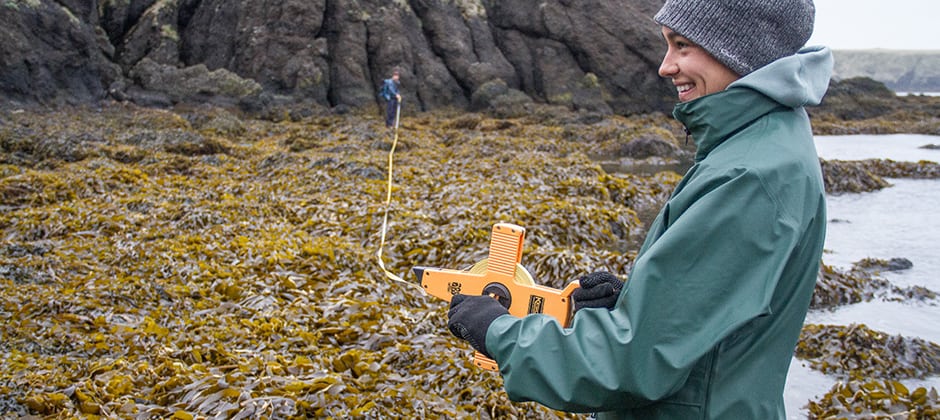Share this article
Coronavirus, powerful predators and an island of rats
If 2021 was supposed to bring a respite from the coronavirus, it didn’t quite work out that way. The virus continued to dominate the news, and for readers of wildlife.org, it dominated their attention, too. The virus made surprising inroads among white-tailed deer in the United States, raising new questions and concerns.
But that wasn’t the only topic getting our attention. Here are some of the most-read stories from the year.
Daunting Diseases
A number of species are susceptible to SARS-CoV-2, the virus that causes COVID-19 in humans. Because ferrets are known to be among them, some captive ferrets at the National Black-footed Ferret Conservation Center received experimental vaccines, and the center increased safety protocols to protect the endangered species. “They have done a magnificent job in keeping those animals safe,” said Tonie Rocke, a research scientist with the USGS National Wildlife Health Center.
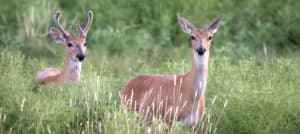
White-tailed deer in Oklahoma have tested positive for the virus that causes COVID-19 in humans.
Credit: Larry Smith
Coronavirus is also prevalent in white-tailed deer. They first showed minor symptoms after being exposed to the virus in a lab setting. Later, they contracted it in the wild. Researchers found antibodies to SARS-CoV-2—the virus that causes COVID-19 in humans—in deer sampled in Michigan, Illinois, New York and Pennsylvania. Further research found the active virus, shedding among deer in Iowa—where scientists believe it was likely spread by humans—and in Oklahoma.
As if the coronavirus wasn’t enough, a mysterious disease began affecting birds in the Mid-Atlantic last summer. First spotted around Washington, D.C., the disease caused blindness as well as neurological symptoms—the birds couldn’t fly, and their heads were often bent toward the ground.
Potent Predators
As once-extirpated predators return to the landscape, researchers discovered some unexpected behaviors this past year.
Cases of wolves killing humans are extraordinarily rare—but they do happen. Researchers compiled reports of wolf attacks around the world and found reliable reports involving 489 victims between 2002 and 2020. Most were related to rabid wolves, but 67 people were victims of what appeared to be predatory attacks, including nine who were killed. “Most people in North American and Europe can live very close to wolves and be perfectly OK in 99.99999% of cases,” said researcher John Linnell. “But it’s never 100%. Things can happen.”
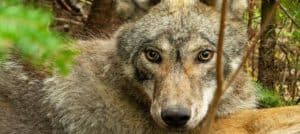
Researchers found that wolves have evolved ambush hunting tactics to catch and kill beavers.
Credit: Voyageurs Wolf Project
There’s nothing new about wolves occupying Voyageurs National Park in Minnesota, but their hunting behaviors still surprise us. It’s not uncommon for wolves there to try to make a meal out of a beaver. It’s not easy, either. It can take up to 14 hours sometimes—for wolves to ambush them, but the beavers often get away. “They’re football-shaped pieces of muscle with gnarly teeth,” said Thomas Gable, project lead of the Voyageurs Wolf Project. “All they have to do is reach the water to get away from a wolf.”
As wolves expand into the National Elk Refuge in Wyoming, they’re muscling out mountain lions. Researchers found the wolves outcompeted—and in some cases preyed on—mountain lions. “They’re not going to be wiped out, but they are going to change the way they’re living.” researcher Mark Elbroch said.
In the Great Basin, mountain lions are having more success—taking down adult feral horses—but it comes at an energetic cost. “It’s a rough life trying to take down 800-1,000-pound animals consistently,” Jon Beckmann said
As black bears naturally recolonize northeast Oklahoma, researchers wanted to better understand how they use resources in the region. These bears turned out to be warier of humans than bears in many parts of the United States, preferring wild resources to anthropogenic ones. But there was one exception. “Bears would come in and just absolutely demolish the deer feeders,” said researcher Elliot Lustig.
Surprising Snakes
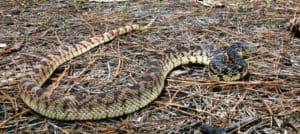
Louisiana pinesnakes are usually very cryptic, staying underground for most of their lives. Credit: Chris Melder
How do you find a Louisiana pinesnake in the forest? It isn’t easy. Researchers can spend thousands of hours trying to track down the cryptic snakes. But environmental DNA can help researchers find the genetic traces they leave behind. Taking soil samples, researchers were able to find area the snakes had passed through. “This thing that had been a bit of a moonshot turned out to work,” said researcher Mark Davis.
Another snake species, timber rattlers, aren’t so cryptic, but they need room to roam, researchers found. At a nature preserve in Tennessee, biologists managed to implant snakes with radio transmitters and track their movements over four years. They found the rattlers spent nearly half their time outside the park’s boundaries in search of mates. “Most rattlesnakes traveled through the nature preserve and into patchy agricultural areas and rural housing properties while foraging for food and searching for mates. “A combination of land sparing and land-sharing” could help protect them and other species, said researcher Eric Nordberg.
Escape from Rat Island
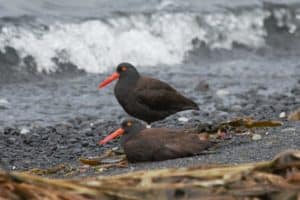
Eradicating invasive rats helped black oystercatcher populations recover on the island. Credit: Island Conservation/Rory Stansbury
If you’re thinking about an island getaway, Rat Island doesn’t sound so inviting. But how about Hawadax? The Aleutian island used to be overrun with invasive rats, and they dominated its ecosystem. Two years of eradication efforts proved successful, though, and Rat Island shed both its rats and its name. Seabirds have returned, and the ecosystem looks similar to nearby islands that never had rats. “They’re pretty amazing animals, and you appreciate them for the wild animal that they are,” researcher Carolyn Kurle said. “That being said, they wreak a lot of havoc.”
Header Image: Researcher Carolyn Kurle measures transects of Rat Island as part of her research looking at the extent of rat invasion on the island. Credit: Island Conservation/Rory Stansbury.



